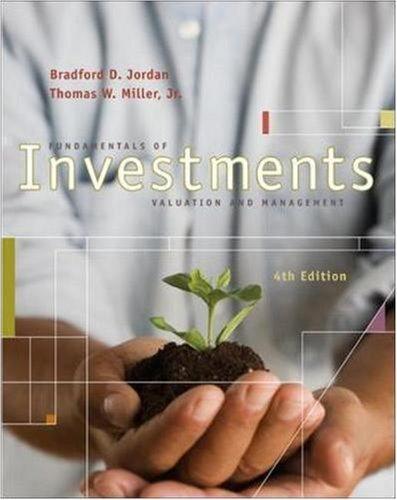Answered step by step
Verified Expert Solution
Question
1 Approved Answer
Consider a market with two risky assets A and B. M is the market portfolio. F is the risk- free asset. This is a perfect
Consider a market with two risky assets A and B. M is the market portfolio. F is the risk- free asset. This is a perfect market with no taxes or other frictions, and the prices given are equilibrium prices. All returns are annual returns.
|
| Expected Return | Standard Deviation | Correlation Matrix | Beta () | |||
| A | B | M | F | ||||
| A | 5.97% | 17.00% | 1.00 | 0.20 | 0.40 | 0.00 | ?? |
| B | 9.35% | 21.00% | 0.20 | 1.00 | 0.60 | 0.00 | ?? |
| M | 9.00% | 12.00% | 0.40 | 0.60 | 1.00 | 0.00 | 1.00 |
| F | 2.00% | 0.00% | 0.00 | 0.00 | 0.00 | 1.00 | 0.00 |
- Calculate the beta of security A and B. If you are forming an equal weighted portfolio which consist of security A and B, what is the portfolio beta?
- Suppose that you are forming a portfolio (called portfolio 1) with 35% weighting on security A and 65% weighting on security B. Calculate the expected return and the standard deviation of return for portfolio 1. Show your calculations.
- Suppose that you intend to form a portfolio (called portfolio 2) which consists of the market portfolio (M) and the risk-free asset (F) with the expectation of obtaining the same expected return as portfolio 1 in part (b) above. What weights would achieve this result? Show your calculations.
- What is the difference between covariance and correlation?
- What is the role played by correlation in determining portfolio expected return and risk? Explain.
Step by Step Solution
There are 3 Steps involved in it
Step: 1

Get Instant Access to Expert-Tailored Solutions
See step-by-step solutions with expert insights and AI powered tools for academic success
Step: 2

Step: 3

Ace Your Homework with AI
Get the answers you need in no time with our AI-driven, step-by-step assistance
Get Started


